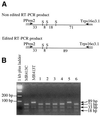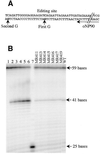A single alteration 20 nt 5' to an editing target inhibits chloroplast RNA editing in vivo
- PMID: 11266552
- PMCID: PMC31290
- DOI: 10.1093/nar/29.7.1507
A single alteration 20 nt 5' to an editing target inhibits chloroplast RNA editing in vivo
Abstract
Transcripts of typical dicot plant plastid genes undergo C-->U RNA editing at approximately 30 locations, but there is no consensus sequence surrounding the C targets of editing. The cis-acting elements required for editing of the C located at tobacco rpoB editing site II were investigated by introducing translatable chimeric minigenes containing sequence -20 to +6 surrounding the C target of editing. When the -20 to +6 sequence specified by the homologous region present in the black pine chloroplast genome was incorporated, virtually no editing of the transcripts occurred in transgenic tobacco plastids. Nucleotides that differ between the black pine and tobacco sequence were tested for their role in C-->U editing by designing chimeric genes containing one or more of these divergent nucleotides. Surprisingly, the divergent nucleotide that had the strongest negative effect on editing of the minigene transcript was located -20 nt 5' to the C target of editing. Expression of transgene transcripts carrying the 27 nt sequence did not affect the editing extent of the endogenous rpoB transcripts, even though the chimeric transcripts were much more abundant than those of the endogenous gene. In plants carrying a 93 nt rpoB editing site sequence, transgene transcripts accumulated to a level three times greater than transgene transcripts in the plants carrying the 27 nt rpoB editing sites and resulted in editing of the endogenous transcripts from 100 to 50%. Both a lower affinity of the 27 nt site for a trans-acting factor and lower abundance of the transcript could explain why expression of minigene transcripts containing the 27 nt sequence did not affect endogenous editing.
Figures





Similar articles
-
Edited transcripts compete with unedited mRNAs for trans-acting editing factors in higher plant chloroplasts.Gene. 2001 Jul 11;272(1-2):165-71. doi: 10.1016/s0378-1119(01)00545-5. Gene. 2001. PMID: 11470522
-
A heterologous maize rpoB editing site is recognized by transgenic tobacco chloroplasts.Mol Cell Biol. 1997 Dec;17(12):6948-52. doi: 10.1128/MCB.17.12.6948. Mol Cell Biol. 1997. PMID: 9372927 Free PMC article.
-
Expression of complementary RNA from chloroplast transgenes affects editing efficiency of transgene and endogenous chloroplast transcripts.Nucleic Acids Res. 2005 Mar 8;33(5):1454-64. doi: 10.1093/nar/gki286. Print 2005. Nucleic Acids Res. 2005. PMID: 15755747 Free PMC article.
-
The plastid transcription machinery and its coordination with the expression of nuclear genome: Plastid-Encoded Polymerase, Nuclear-Encoded Polymerase and the Genomes Uncoupled 1-mediated retrograde communication.Philos Trans R Soc Lond B Biol Sci. 2020 Jun 22;375(1801):20190399. doi: 10.1098/rstb.2019.0399. Epub 2020 May 4. Philos Trans R Soc Lond B Biol Sci. 2020. PMID: 32362266 Free PMC article. Review.
-
Sense from nonsense: how the genetic information of chloroplasts is altered by RNA editing.Biochimie. 2000 Jun-Jul;82(6-7):549-57. doi: 10.1016/s0300-9084(00)00610-6. Biochimie. 2000. PMID: 10946106 Review.
Cited by
-
An in vitro RNA editing system from cauliflower mitochondria: editing site recognition parameters can vary in different plant species.RNA. 2005 Oct;11(10):1563-70. doi: 10.1261/rna.2740905. Epub 2005 Aug 30. RNA. 2005. PMID: 16131591 Free PMC article.
-
Post-transcriptional control of chloroplast gene expression.Gene Regul Syst Bio. 2009 Mar 12;3:31-47. doi: 10.4137/grsb.s2080. Gene Regul Syst Bio. 2009. PMID: 19838333 Free PMC article.
-
Two RNA editing sites with cis-acting elements of moderate sequence identity are recognized by an identical site-recognition protein in tobacco chloroplasts.Nucleic Acids Res. 2008 Jan;36(1):311-8. doi: 10.1093/nar/gkm1026. Epub 2007 Nov 21. Nucleic Acids Res. 2008. PMID: 18032432 Free PMC article.
-
A study of new Arabidopsis chloroplast RNA editing mutants reveals general features of editing factors and their target sites.Plant Cell. 2009 Nov;21(11):3686-99. doi: 10.1105/tpc.109.071472. Epub 2009 Nov 24. Plant Cell. 2009. PMID: 19934379 Free PMC article.
-
A comparative genomics approach identifies a PPR-DYW protein that is essential for C-to-U editing of the Arabidopsis chloroplast accD transcript.RNA. 2009 Jun;15(6):1142-53. doi: 10.1261/rna.1533909. Epub 2009 Apr 24. RNA. 2009. PMID: 19395655 Free PMC article.
References
-
- Maier R.M., Neckermann,K., Igloi,G.L. and Kössel,H. (1995) Complete sequence of the maize chloroplast genome: gene content, hot-spots of divergence and fine tuning of genetic information by transcript editing. J. Mol. Biol., 251, 614–628. - PubMed
-
- Zito F, Kuras,R., Choquet,Y., Kossel,H. and Wollman,F.A. (1997) Mutations of cytochrome b(6) in Chlamydomonas reinhardtii disclose the functional significance for a proline to leucine conversion by petB editing in maize and tobacco. Plant Mol. Biol., 33, 79–86. - PubMed
Publication types
MeSH terms
Substances
Grants and funding
LinkOut - more resources
Full Text Sources
Research Materials

